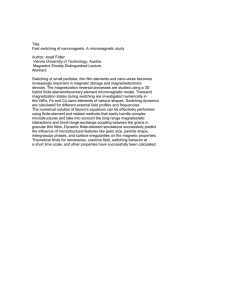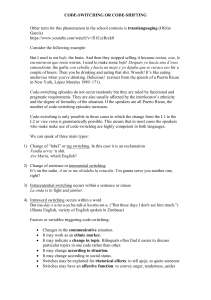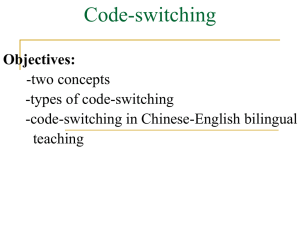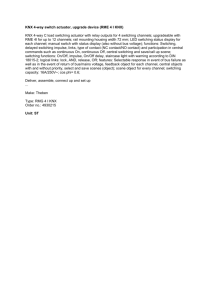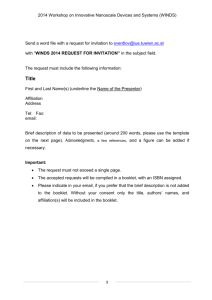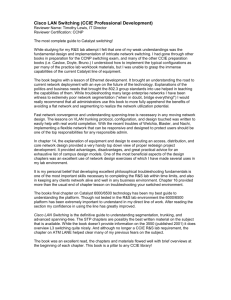Code Switching Powerpoint-FINAL
advertisement
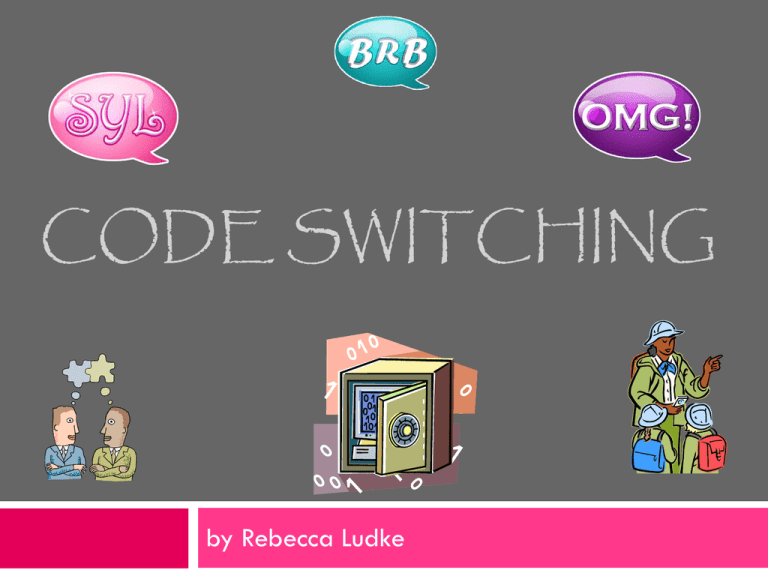
CODE SWITCHING by Rebecca Ludke Qué es code switching? ? http://www.codeswitching.biz/docs/QA.html A simpler definition is the ability to use certain types of languages in specific situations; for example, my student greeting me by saying, “Good morning Miss Ludke, how are you today?” versus the way he/she would greet his/her friend, “Hey, what’s up?” Can you decode these words/phrases heard/written in my middle school classroom? -I love her, she’s my biffle! She is my best friend [for life]. -Man, your girlfriend is a butter face. She has a nice body, but her face is ugly. -OMG Oh my god! -HAGS Have a great summer! -He’s so emo, he never smiles. He seems depressed (and wears all black). -Those kids are Aberzombies. They wear Abercrombie clothing just because it’s popular. -My parents wigged out on me. My parents were very upset with me. -That’s so B.A.! I really like that! Examples of Code Switching in My Life “Rebecca, your dupa is mine if you don’t clean up this kitchen!” – Grandma Stasia - a “loving” phrase heard from my Polish grandmother when I made a giant mess in her kitchen, usually the result of a homemade pasta experiment gone wrong, it meant that I was in big trouble if I didn’t clean up after myself When I was a kid, I loved talking a nap on my grandma’s pierzyna. -a pierzyna is a Polish feather blanket, almost like a small mattress typically laid on the floor “I scored most of my points outside.” -used in typical conversations, with my dad, after my basketball games; the outside would be defined as shots that are far away from the basket, often 3point shots The Benefits of Being Able to Code Switch -People who are able to code switch have a unique ability. They can choose the type of language that is appropriate based on the situation. For example, when you speak with your students, you most likely use different language and tones than when you speak with your significant other. Be careful, sometimes the “teacher voice” comes home! -For politicians, the ability to code switch is vital. At times, they must appear intelligent, cultured, well-informed; however, on other occasions, people want someone they can relate to, someone who speaks like they do. -Code switching allows us to “fit in” with those around us, it makes us (appear) more trustworthy. Issues Related to Code Switching THE PERCEPTION OF OTHERS -In many immigrant communities, code-switching in ordinary conversation may be socially required: those who speak only the language of the country are perceived as assimilationists, while those who speak only the original language, with no borrowings or code-switching, seem over-formal or show-offs. -Some view bilingual code switchers as rude because they feel as if they’re speaking in code to purposely exclude others. THE INABILITY TO PROPERLY CODE SWITCH -Others may be confused as to what is trying to be conveyed -The stigma that a person is ignorant, uncultured, or uneducated OR on the contrary that a person is out of touch, arrogant, etc. -A person may not fit into certain social circles because of language issues/differences VIDEO- kids’ take on code-switching http://videos.apnicommunity.com/Video,Item,728140406.html VIDEO- Code Switching Book Promo (Men vs. Women) http://videos.apnicommunity.com/Video,Item,2336955808.html VIDEO-Liberian Code Switching http://videos.apnicommunity.com/Video,Item,2186604890.html **Videos are Courtesy of the Indian & Bollywood Television Hub Website** I know code switching, but what is code mixing? Another issue closely related to code switching is code mixing. Code mixing can cause problems for bilingual students; however, the ability to code mix means that students are able to understand the syntactic systems of both languages. Drawing from the knowledge one has of language A and inserting its rules into language B demonstrates that the student is mastering both languages. As language development progresses, students will mix the languages less and less (Hulit, 2011). Two Approaches When Working with Bilingual Students The Correctionist Approach Diagnoses the child’s home speech as “poor English” or “bad grammar” (EX: finding that the child does not know how to show plurality, possession, or tense) Assumes that “Standard English” is the only proper form of language and tries to do away with the child’s home language Tends to exclude the children who are not fluent in “Standard English” The Contrastivist Approach Language comes in diverse varieties This “linguistically informed model” recognizes that the student’s home language is not any more deficient in structure than the school language Teachers act as models trying to help children become explicitly aware of the grammatical differences between the formal and informal languages What’s a teacher to do? Teachers have a tough job! (I’m preaching to the choir, I know.) It is our job to teach proper grammar to our students. However, we must also honor and dignify our students’ other language(s). Therefore, we can correct the students, but only to show them the appropriate times to use particular types of language. Think about it… if you injure yourself in front of your students, would you say s!#*? No, but at home you might.

